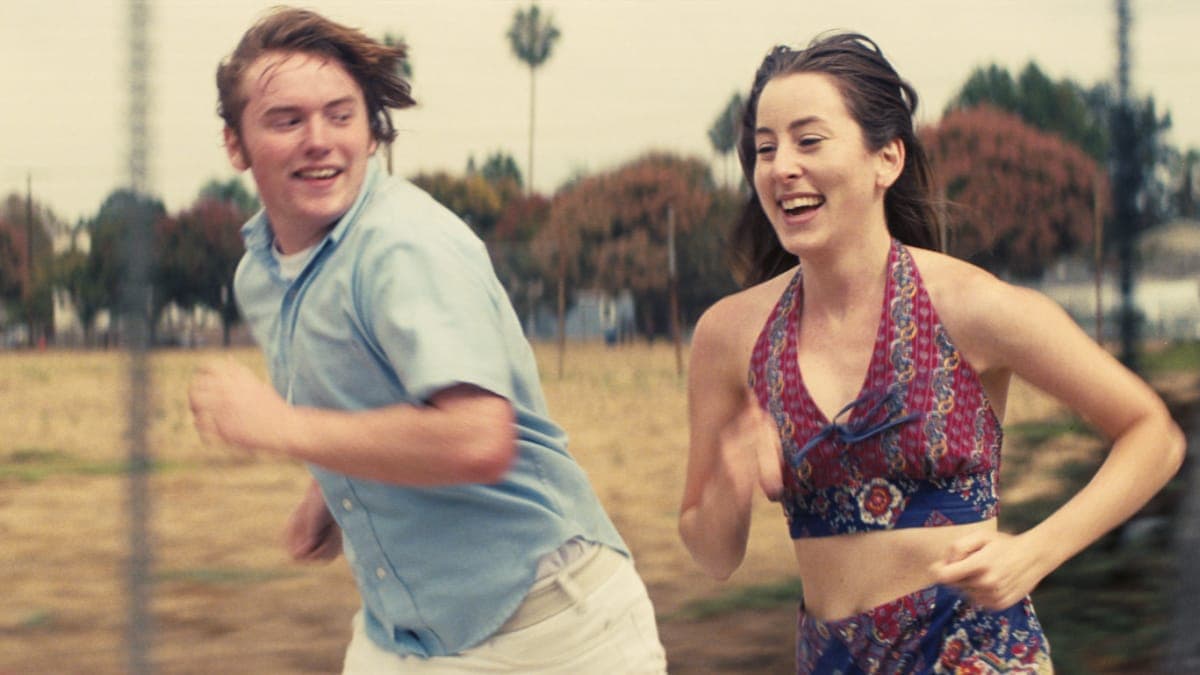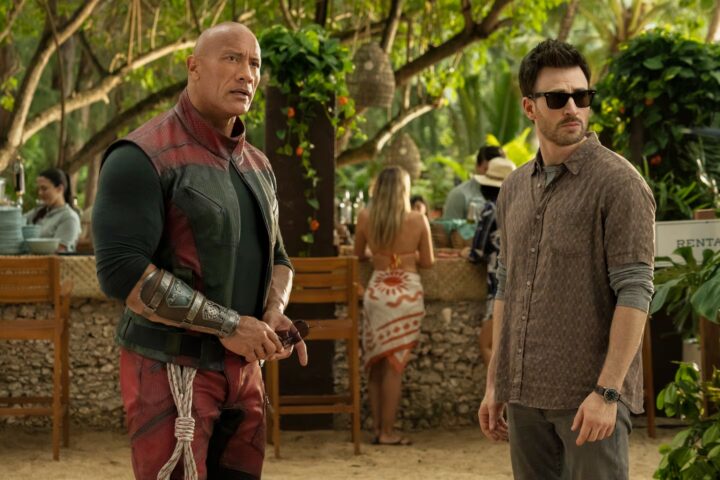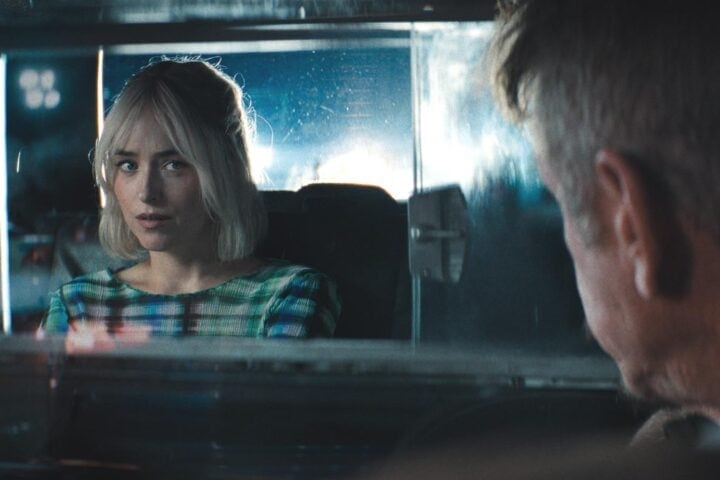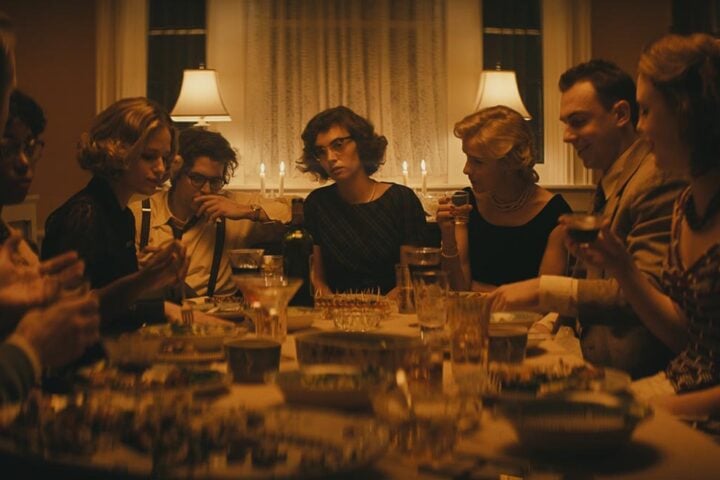Early in Paul Thomas Anderson’s Licorice Pizza, a light, diverting scene is jarringly cut short when cops storm in out of nowhere to dogpile Gary Valentine (Cooper Hoffman) as he holds court on a convention floor about Soggy Bottoms, his burgeoning waterbed business. The charge? Gary is suspected of murder. For a brief moment, there’s a sense that what has up to this point been a footloose screwball comedy about two naïve young souls might morph genres altogether, specifically into a crime thriller. Instead, the scene is a misdirect, as the cops are mistaken, and the pro forma violence inflicted upon unsuspecting Gary turns out to be all for naught. The film resumes its business as though nothing happened.
Nevertheless, a sequence that may otherwise have been merely an amusing non sequitur—functionally something like Anderson’s answer to the squawking cockatoo from Orson Welles’s Citizen Kane—is complicated by a fleeting shot of a haggard detainee who’s violently jerked into a police department waiting room to get a look at the precocious, ginger-haired Gary. In a film otherwise drunk off the sense of infinite possibility and forward momentum generally afforded by youth and more specifically by Los Angeles in the ’70s, this is one of a handful of pointed moments that suggests a rougher, less flattering reality around the edges of the California dream, and it leaves an aftertaste that lingers throughout Licorice Pizza.
Following on the heels of a handful of films orchestrated in stately legato, Anderson’s ninth feature is a rollicking picaresque that chugs along in hurtling tracking shots and montages scored to contemporaneous radio hits. But the air of carefree playfulness doesn’t fully amount to rose-colored nostalgia, as Anderson sprinkles enough hints of danger, inequity, and societal breakdown throughout to lend his autobiographical jam session a sneaky depth of feeling.
Musical metaphors are an apt framework for Anderson’s filmography given his long-running associations with various major artists, among them Fiona Apple, Joanna Newsom, and Radiohead. But they’re especially suitable here given Licorice Pizza’s prominent casting of the L.A. sister trio of HAIM, with whom Anderson has been collaborating since 2017. It’s Alana Haim, as Gary’s love interest Alana Kane, who gets top billing, and she rises to the occasion with a performance of great sensitivity and nuance. And the Kane clan is played by the entire Haim family, with sisters Danielle and Este filling in as Alana’s pesky older siblings and parents Moti and Donna making their screen debuts as the deadpan heads of the household.
As a young man, Anderson was taught art at the Buckley School by the Haim matriarch, who would later transition from a life in music and painting to a successful real estate career. Such an origin story helps to explain why Licorice Pizza takes form not only as a paean to the San Fernando Valley of Anderson’s youth, but also as an appreciation of the particular breed of eccentrics who thrived in his hometown—people who can move fluidly between creative and commercial pursuits by virtue of their lifelong proximity to both.
Gary is one such figure, a resourceful 16-year-old who finds the 25-year-old Alana at a time in his life when he’s already well established as a hard-gigging actor who counts his mother (Mary Elizabeth Ellis) as his manager. Our first glimpse of Gary comes through a portable makeup mirror held up by Alana while on the job as a high school photo day assistant, an early clue that the anchorless post-grad sees something of herself in the pudgy dynamo.
Gary and Alana strike up a conversation on the way to the school gym that’s been converted into a photo studio, and their quick-witted back and forth emphasizes the conflict that drives the film’s narrative: Gary is unwavering in his faith that they’re destined for companionship, and Alana is teasingly staunch in her rebuttal that Gary’s too young for her. Not unlike Phantom Thread, another tale of a peculiar partnership forged by a man and woman from conflict and compromise, Licorice Pizza goes about dismantling the apparent gulf between its two leads, building toward a bond that’s simultaneously chaste and impassioned.
The above exchange is captured in lengthy, tightly choreographed tracking shots that center on Gary and Alana. All the while, every inch of the Cinemascope frame is filled with a nondescript swirl of background activity, an oft-repeated visual strategy throughout the film that highlights the tunnel vision shared by these two within a vibrant social environment.
As Gary pivots from acting to a string of small-business rackets, Licorice Pizza expands in scope to accommodate concentric circles of L.A. subculture: the scrappy breeding ground of local business, the glamorous realm of Hollywood royalty, and the seemingly elevated arena of municipal politics. Both characters ultimately find their respective kingdoms: For Gary, it’s a high-ceilinged department store where he lords over his waterbed venture and then a bacchanalian pinball nightclub, while Alana, attempting to strike off on her own after he finagles a string of acting prospects for her, is momentarily led to believe that she’s found her calling as an assistant in the office of mayoral candidate Joel Wachs (Benny Safdie).
In its drive-by tour of these various worlds, Licorice Pizza kicks up a bounty of spirited supporting performances, from Harriet Sansom Harris’s overzealous casting agent to Tom Waits and Sean Penn’s pair of sozzled Old Hollywood egomaniacs. The latter two preside over a mesmerizing centerpiece sequence at Tail o’ the Cock, a wood-and-red-leather prime rib palace where Gary is a regular, and which happens to be the preferred stomping ground for assorted industry types looking for a martini on their way home from the studio. It’s here where, at a point of conflict, Gary brings a pair of high school girls and Alana provokes his jealousy by cozying up to the sleazy producer Jack Holden (Penn).
Always amused by male sexuality and the impact of its repression, Anderson has never been one to shy away from a cheap dick joke, and while the presence of Tail o’ the Cock in the film might seem like an overly punny summation of our hero’s journey, the name of this watering hole is actually grounded in historical verisimilitude. Based on an actual institution that shuttered in 1987, the Tail o’ the Cock is recreated with clear nostalgic affection, its autumnal lighting and festive atmosphere suggesting an almost magical waystation for larger-than-life miscreants and braggarts. This impression is solidified when Waits’s Rex Blau announces a mysterious ritual on a nearby golf course, a scene that’s downright Felliniesque in its foggy atmosphere and surreal sense of spectacle, and which ultimately provides an elaborate stage for Gary and Alana to work through an episode of performative antagonism.
Licorice Pizza accumulates such lavish set pieces and lived-in details in brisk succession without ever losing sight of its central slow-burn romance. Indeed, the chaotic churn of activity around Gary and Alana only serves to heighten the will-they-or-won’t-they tension between them. In a telling juxtaposition, TV news coverage of President Richard Nixon discussing the oil crisis of 1973 is overheard at the exact moment that Gary peeps some classified ads for the films Deep Throat and Swedish Wife Exchange Club—intimations of the era’s blossoming sexual liberation jutting up against its dominant conservatism.
If Jacques Demy’s great 1969 film Model Shop equated the emptying of a gas tank in L.A. with a kind of metaphysical death, Licorice Pizza provocatively pairs a citywide shortage with an eruption of libido. As society goes haywire, Gary and Alana’s bond deepens, spurred on by a combative encounter with the insatiably sex-crazed producer Jon Peters (Bradley Cooper), who, after breaking down en route to a movie date with Barbra Streisand, storms the streets on the hunt for gas and pussy, an absurd sequence capped off by a lovely, silhouetted shot of Gary and his friends miming penetrative acts with the nozzle of a jerrycan.
Anderson again indulges his penchant for locating the comedy in hyper-driven heterosexuality; think of Jon Peters as a pre-sermonizing version of Tom Cruise’s Frank T.J. Mackey in Magnolia. But in Licorice Pizza’s denouement there’s also an acknowledgement of the darker underbelly of the oppressive heteronormativity of the ’70s. In a sequence of understated eloquence, as opposition to Wachs’s campaign mounts, Alana must confront head on that the adult world she aspires to and self-consciously identifies with to deny her attraction to Gary is a more multifaceted and treacherous place than she accounts for.
On the surface, Licorice Pizza may be Anderson’s most uncomplicatedly romantic film, as it presents a pair of searching souls who seem made for each other and proceeds to tear away the perceived barriers between them over the course of two spectacularly entertaining hours. But its subtle recognition of a thornier reality on the margins of Gary and Alana’s charmed path spikes the crowd-pleasing payoff with a dash of arsenic. As in Phantom Thread, love is shown to be an escape from reality, a regression to a youthful state of innocence that temporarily conceals the more challenging parts of ourselves—and in this film, of society itself.
Since 2001, we've brought you uncompromising, candid takes on the world of film, music, television, video games, theater, and more. Independently owned and operated publications like Slant have been hit hard in recent years, but we’re committed to keeping our content free and accessible—meaning no paywalls or fees.
If you like what we do, please consider subscribing to our Patreon or making a donation.





